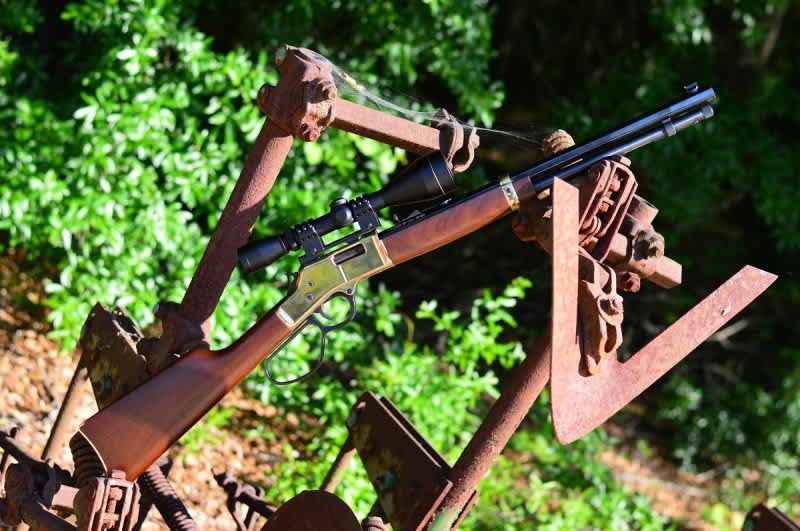Henry Big Boy Rifle in .357 Magnum
Jim Grant 05.14.15

Pistol-caliber carbines are awesome; even more so when they share ammo with a powerful sidearm. This was the original reason why I sought the Henry Big Boy rifle—I wanted a carbine to share ammo with my go-to outdoors gun, the Ruger GP100 Match Champion. While the .357 Magnum round is known for its fight-stopping capability, can it truly compete with lever-gun classics like .30-30, or is it doomed to share the fate of the allegedly-anemic .30 Carbine?
Manufactured in Bayonne, New Jersey, current-production Henry Rifles share very little with their original namesake product. Not to say the new rifles aren’t well made, but they take the lever-action, front-loading under barrel magazine tube-fed design and modernize its construction. Gone is the case-hardened steel and solid-brass receiver in favor of forged steel and brass-alloy components. The result is stunning.
The brass alloy employed on Henry rifles is gorgeous and significantly lighter than true brass, with increased pressure resistance and durability. Although this new iteration of the Henry seems to dispatch many of the old-world aspects of the original, it retains enough to elicit nostalgia from old Western fans while providing quality to back it up.

The new Big Boy sports features like its heavy, octagonal 20-inch barrel and buckhorn sights. The former not only looks great, but soaks up all the cartridge’s recoil while doubling as a heat-resistant, accuracy-retaining bull barrel. The sights, while somewhat tricky to use at distance, are adjustable and fairly robust. Shooters looking for more accuracy from their carbine can opt for either a Henry-made scope mount or aftermarket tang-mounted aperture sights that increase the sight radius and add some old-world charm to the design.
Other than nostalgia, what good is a front-loading .357 Magnum carbine?
More than most shooters would think. While the ornate finish of the flashy lever-gun doesn’t make it the best choice for a hunting rifle, its ability to share ammunition with thousands of different .38 Special and .357 Magnum revolvers cements its place as a solid bug-out carbine.
One ballistic trinity that I really enjoy with this rifle is my S&W 442 and a Ruger GP100 Match Champion. This gives shooters three solid options when bugging out. They’ve got the 442 for concealed carry, which is small enough to slip in a pocket even when the shooter is sleeping. Then they’ve got the Match Champ for mid- to short-range threats that they can rely on to work under all conditions and can shoot with questionable loads due to its tank-like construction. Combine these two pistols with a soft-shooting carbine that squeezes more power from the already hard-hitting .357 Magnum round and shooters can not only defend themselves, but also hunt deer with the same cartridge.

Fired from a rest to determine its maximum accuracy potential, six varieties of ammunition were tested in the Henry Big Boy. The first three were common .38 Special loads: two plinking rounds (PPU 158-grain LRN and M&D 148-grain wadcutters) and one self-defense cartridge (Hornady’s +P 110-grain FTX Critical Defense). Both plinking rounds experienced serious amounts of drop, impacting the earth 20 yards short of the target. Moving back to 50 yards, these loads both grouped around 2.5 inches, with the wadcutter round grouping slighter better. The defensive round reached the target at 100 yards, but struck the base of it, making zero difficult. Moving back to 50 yards, the Hornady round grouped an impressive 1.1 inches.
Unimpressed with the .38 Special’s artillery-like trajectory, I excitedly loaded the Henry rifle with some of my favorite .357 Magnum loads—Winchester PDX1 Defender 125-grain Bonded JHP, Federal Vital-Shok 180-grain Castcore, and MagTech 158-grain FMJ.
All of these loads successfully reached the targets at both 100 and 150 yards, showing a tremendous improvement over the comparably anemic .38 Special loads. The most accurate load was the PDX1 Defender, grouping 1.63 inches at 100 yards. It was closely followed by the hard-hitting cast lead Federal Vital-Shok at 2.14 inches and the MagTech FMJ at 2.88 inches.
On a previous occasion, I had shot the Henry for accuracy with many of these same loads and achieved markedly less impressive results. The difference? Optics. The buckhorn iron sights on the Henry rifle require 20/15 vision to properly use past 100 yards. This is due to the sight’s diminutive size and relatively short sight radius.

Tipping the scales at a hair under nine pounds unloaded, the Henry Big Boy isn’t much fun to carry around. It certainly isn’t cheap, either—it retails for around $900. That said, I can’t recall a manually-operated firearm I enjoy shooting more. Living up to its namesake, the Henry Big Boy evokes the same excitement many shooter felt as a kid with their first .22 LR. Plinking tin cans or steel plates with the Henry is more fun than it should be.
This is especially true when paired with a lightweight red dot sight. It’s anything but traditional, though it makes perfect sense. The Henry has a limited effective range, handles extremely fast for its weight, and has next to no recoil. I’m tempted to have a gunsmith mill a cut in the barrel for a scout rail to turn the Henry into a brush gun, but may wait for the .44 Magnum version for its increased effectiveness on medium game.

